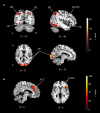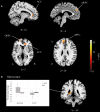Children With Dyscalculia Show Hippocampal Hyperactivity During Symbolic Number Perception
- PMID: 34354576
- PMCID: PMC8330842
- DOI: 10.3389/fnhum.2021.687476
Children With Dyscalculia Show Hippocampal Hyperactivity During Symbolic Number Perception
Abstract
Dyscalculia is a learning disability affecting the acquisition of arithmetical skills in children with normal intelligence and age-appropriate education. Two hypotheses attempt to explain the main cause of dyscalculia. The first hypothesis suggests that a problem with the core mechanisms of perceiving (non-symbolic) quantities is the cause of dyscalculia (core deficit hypothesis), while the alternative hypothesis suggests that dyscalculics have problems only with the processing of numerical symbols (access deficit hypothesis). In the present study, the symbolic and non-symbolic numerosity processing of typically developing children and children with dyscalculia were examined with functional magnetic resonance imaging (fMRI). Control (n = 15, mean age: 11.26) and dyscalculia (n = 12, mean age: 11.25) groups were determined using a wide-scale screening process. Participants performed a quantity comparison paradigm in the fMRI with two number conditions (dot and symbol comparison) and two difficulty levels (0.5 and 0.7 ratio). The results showed that the bilateral intraparietal sulcus (IPS), left dorsolateral prefrontal cortex (DLPFC) and left fusiform gyrus (so-called "number form area") were activated for number perception as well as bilateral occipital and supplementary motor areas. The task difficulty engaged bilateral insular cortex, anterior cingulate cortex, IPS, and DLPFC activation. The dyscalculia group showed more activation in the left orbitofrontal cortex, left medial prefrontal cortex, and right anterior cingulate cortex than the control group. The dyscalculia group showed left hippocampus activation specifically for the symbolic condition. Increased left hippocampal and left-lateralized frontal network activation suggest increased executive and memory-based compensation mechanisms during symbolic processing for dyscalculics. Overall, our findings support the access deficit hypothesis as a neural basis for dyscalculia.
Keywords: dyscalculia; functional magnetic resonance imaging; hippocampus; learning disabilities; number sense.
Copyright © 2021 Üstün, Ayyıldız, Kale, Mançe Çalışır, Uran, Öner, Olkun and Çiçek.
Conflict of interest statement
The authors declare that the research was conducted in the absence of any commercial or financial relationships that could be construed as a potential conflict of interest.
Figures



References
-
- American Psychiatric Association (2013). Diagnostic and Statistical Manual of Mental Disorders, 5th Edn. Washington, DC: American Psychiatric Publishing.
LinkOut - more resources
Full Text Sources

